Nationals Park
Washington, DC
New York Mets at Washington Nationals
June 2, 2010
By
Ken Schlapp
The Nationals new stadium opened up in
2008 and I did manage to catch a game there that season, but I did
not keep score or have a camera with me, so I did not register or
log my first game until 2010. I have to thank my job at Segal for
giving me the opportunity to catch sporting events around the
country while I make my annual visits to each of our locations. I
also have the benefit of scheduling the dates of my travel.
Therefore, my annual trip to Washington coincidentally coincided
with a visit to Washington, DC by the New York Mets. Hiroko was not
able to join me this time, but my friend Efrem Goldman drove down
from New Jersey to catch a game with me.
We figured that we would get a head
start on seeing the stadium by getting there early in the morning,
well 10:30 AM anyway, to catch the first stadium tour of the day.
We took the train from DuPont Circle, where we were staying, to the
Navy Yard – Stadium stop on the green line. The Metro is the best
way to get there.
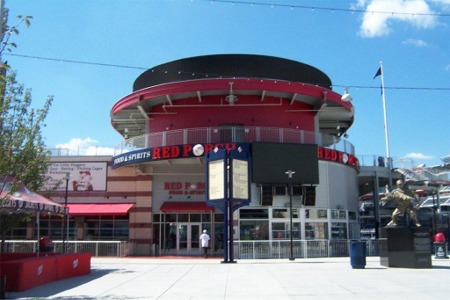 Therefore,
I always go that way. Once you get off the station, it is a short
one-block walk to the centerfield gate, where the tours start. As
you get there, the first thing you notice is the Red Porch
Restaurant, which is a spot you can eat, have meetings, party, and
see the game all at once. Therefore,
I always go that way. Once you get off the station, it is a short
one-block walk to the centerfield gate, where the tours start. As
you get there, the first thing you notice is the Red Porch
Restaurant, which is a spot you can eat, have meetings, party, and
see the game all at once.
We bought our tickets right by the
center field gate, where the ticket offices are situated, and got
started on our tour with a group of people almost immediately. I
thought it was pretty cool that I immediately noticed a bunch of old
Washington Senators banners up on the ceiling by the ticket booth.
This gave me a good feeling from the start about their recognition
of local baseball history.
The first stop on our tour was to see
the Big Train statue, which is, of course, for Walter Johnson, who
was one of the best pitchers in baseball history. He played his
entire career with the Washington Senators of the American League
from 1907 to 1927 and finished 2nd on the all-time wins
list at 417. The Senators he played for left Washington in 1961 to
become the Minnesota Twins. The statue is unique in the fact that
his throwing arm displayed in two different angles to capture his
pitching motion, or to indicate he might have had three arms, but I
will go with the former idea. Also in the Center Field Plaza, is a
statue of Frank Howard, who was a player famous for his time with
the expansion Washington Senators in during the 1960s. The
expansion Senators played in the American League from 1961 until the
end of 1971 when they moved to Texas and became the Texas Rangers.
The third Statue is of Josh Gibson, who was a star in Washington
with the Homestead Grays of the Negro Leagues. Again, I am
impressed that they have embraced many aspects of baseball history
in Washington, DC.
Next thing I clearly noticed was the
starting lineup for the Nationals in the form of giant Topps
baseball cards, similar to what they did by the right field ticket
booths at Shea Stadium. That will always catch the attention of
this card collector. It was located on the side entrance, under the
promotional schedule. I noticed additional baseball cards in the
PNC Diamond Club above the sign, but these were tobacco cards of
former
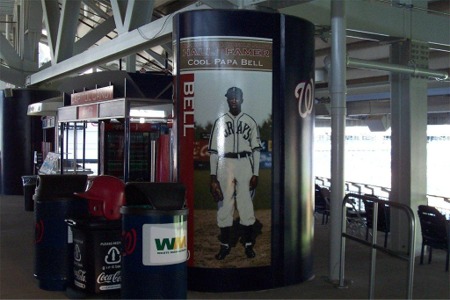 Washington
greats. Our guide then led us through the huge concourses, all of
which leave a view of the game so you will not miss a beat if you
leave your seat for the concession stands, or if you want to simply
stand and watch the game. Washington
greats. Our guide then led us through the huge concourses, all of
which leave a view of the game so you will not miss a beat if you
leave your seat for the concession stands, or if you want to simply
stand and watch the game.
I could not help but notice the big
picture of Cool Papa Bell on the outside of the Capitol Candy Kiosk
to recognize another Washington Hall of Famer from the Grays of the
Negro Leagues. There were several other former Washington star
photos throughout the concourse. We walked through the suite area
where there were numerous posters, photos and facts on Washington
baseball history. We even came across the Homestead Grays bar with
a giant team photo at the end of the bar. More than any team or
stadium that I have visited in the past, this park pays the most
tribute to the Negro Leagues, which is great. I was clearly
impressed with the Washington History, but then I noticed that the
only retired number the Nationals have is # 42 for Jackie Robinson,
which is retired for every team. Then, the more I looked around, I
realized that the Nationals completely forgot about their recent
history as the Montreal Expos. This organization played their games
in Montreal from 1969 until 2004, and not a single mention. The
Expos had retired # 8 for Gary Carter, # 10 for Rusty Staub and
Andre Dawson, and #30 for Tim Raines, but those retired numbers do
not exist here. I asked our guide about that and she agreed that
there was nothing to remember their time in Canada. I found this to
be very disappointing. However, we did walk past a white board with
today’s lineup (including umpires) hand-written on it, which cheered
me up a bit.
We continued to walk around the
stadium and even had the opportunity to sit in the dugout and stand
at the edge of the field, which is always fun. Gazing out from the
dugouts and behind home plate, I will have to say it is a beautiful
field. The seats are all deep blue in this 3-level venue and like
all the new stadiums are angled for the best view, regardless of
your location. Since this is a baseball-only stadium, the seats did
not have to be angled like at RFK where it was OK for Baseball and
Football, but not great for either. I have sat in various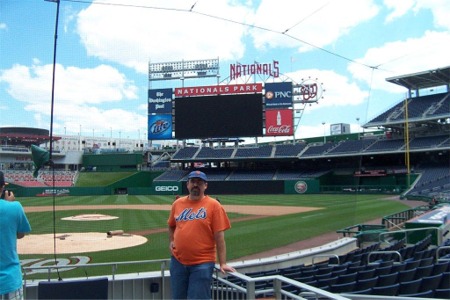 locations at this park and have not been disappointed. I frequently
choose to sit in the upper level behind the plate, which is just
fine. The other interesting thing is that from the right angles,
you can see the Capitol Building from within the stadium.
locations at this park and have not been disappointed. I frequently
choose to sit in the upper level behind the plate, which is just
fine. The other interesting thing is that from the right angles,
you can see the Capitol Building from within the stadium.
The tour was fun, informative and
disappointing all at the same time, but I am always happy to check
out a new stadium in this way. Once the tour was finished, we
headed out for a day as tourists in DC, before hopping right back on
the Metro for the night game. We got back to the stadium in plenty
of time to take a walk around the outside, which we did not do in
the morning. This re-entry to the stadium was better from the
start, because this time we rode the train with many other people
heading to the game, and walked towards the stadium with a crowd.
We were even greeted by Teddy Roosevelt in the street as we headed
towards the center field gate or at least the Teddy Roosevelt that
takes place in the Presidents race each game…details later.
On the walk from the Metro station,
you cannot help, but notice the Bullpen across the street from
Nationals Park. It is an outside beer garden with truck food and
cheaper beer than in the stadium. Therefore, many people head to
the Bullpen before the game to “tailgate” at an outdoor bar, which
is a unique and fun atmosphere. I did not partake in the beer fest
though. I am a huge fan of beer (as long as it is not Bud, Miller
or Coors), but I rarely drink at games, because I do not want to
miss any part of a game either waiting on line for a beer or the
restroom. I may have regretted that position after we went into the
stadium, because I learned that they actually have good beer in the
stadium too, in the form of Dogfish Head and Flying Dog Beer.
From our walk around the outside of
Nationals Park, I got the impression that we were looking at a
whitish office building more than a baseball field. The stadium
definitely has a modern business-like feel to it, which I confess to
like. Too many of the new stadiums try too hard to make them retro,
when that is not always necessary. I like many of those stadiums,
but they do not always fit their surroundings. Camden Yards clearly
fits with the neighborhood it was built in and is beautiful and
great. Coors Field, howeve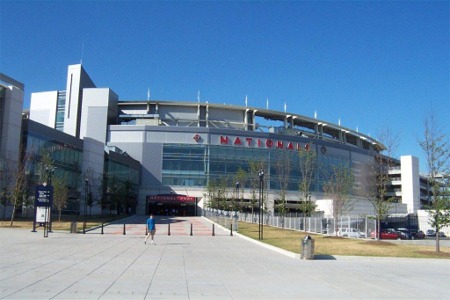 r,
feels like they squeezed in a replica of Camden Yards in a place it
does not belong. Washington, DC is a newer modern city, and I
believe this new office-building stadium is a perfect fit. I really
like that they simply made a modern stadium. r,
feels like they squeezed in a replica of Camden Yards in a place it
does not belong. Washington, DC is a newer modern city, and I
believe this new office-building stadium is a perfect fit. I really
like that they simply made a modern stadium.
The only thing on the outside of the
stadium that stands out is by the back entrance where there is a
long walkway with large red years (1859, 1910, 1924, 1937, 1948,
1961, 1971, 2005, & 2008) cascading towards the entrance. In
addition, there is a 1924 Statue with a plaque to commemorate the
Washington Senators’ only World Series Championship. I did not find
out what the all the years signify at the time of this games, but I
tried to do some research about it since, and have come up with
nothing. I looked up stadium information on Wikipedia, the
Nationals web site, and anywhere else on the internet, I could think
of, but I came up empty. I find this pretty strange, but I will
take a guess at what the significance of the dates mean:-
-1859 – This was the year that the
first Washington Nationals Base Ball Club was founded in DC
-1910 – This was Walter Johnson’s breakout year as a big star
-1924 – The Senators defeat the New York Giants in the World Series
for the team’s only championship
-1937 – The All-Star Game was held in Griffith Park in Washington,
DC
-1948 – I have no clue
-1961 – This was the year the Washington Senators moved to
Minneapolis and the Expansion Washington Senators began play
-1971 – This was the last year in Washington for the Senators before
moving to Texas as the Rangers
-2005 – This was the year the Nationals began playing in Washington
after leaving Montreal as the Expos (you would think they would
include 1969 as well, which was the first year of the franchise’s
existence)
-2008 – This was the first year at Nationals Park
Ok, we finally headed back in the
stadium for the game, which was in time to see the Nationals’ Bald
Eagle Mascot, which is of course the symbol of our nation and
perfectly fits with our capitol’s team. We were looking forward to
seeing our Mets get out there and play, regardless of how
disappointing they have been lately. They even got off to an
exciting start, with a typical Mets rally. Ruben Tejada got on base
by getting hit by a Luis Atilano pitch, moved to 3rd on
David Wright’s single, and scored the game’s first run on an RBI
groundout to 2nd base by Ike Davis.
Jonathan Niese pitched well for the
Mets from the start by holding the Nationals scoreless for the first
6 innings. The Mets were also held down until exploding for 4 runs
in the top of the 4th. David Wright got the rally going
with a double. Ike Davis and Jason Bay followed with walks to load
the bases for Rod Barajas, who failed to come through. He flew out
to shallow center field, which prevented Wright from scoring. Jeff
Francoeur did not fare any better, as he lined out to short, which
made it look like Atilano would escape the inning without any
damage, but Alex Cora had other ideas. He blasted a triple to clear
the bases and then came home as well on an RBI double by Mets
pitcher Niese helping himself out. This also knocked Atilan out of
the game after giving up 5 runs in 3.2 innings with 4 hits, 2 walks
and 4 strikeouts.
The real excitement of the game
happened after the Mets were finally out in the top of the 4th.
This is the point in every Nationals home game i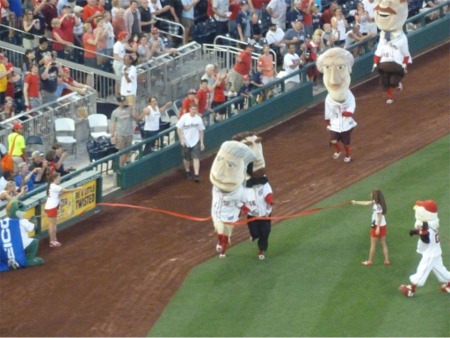 n
which the Presidents race takes place. The race is similar to the
sausage race in Milwaukee, but here the race takes place with giant
head versions of George Washington, Thomas Jefferson, Abe Lincoln,
and Theodore Roosevelt. On this day, Thomas Jefferson took an early
lead, even “hot-dogging it” as he ran across the finish line.
However, that was not the only antics during the race, Abe Lincoln
veered off course at the last minute with an open field tackle of
the GEICO Gecko. This is always fun and a great tradition, but I
believe that there is an anti-New York bias in these races. Teddy
Roosevelt, the only New York president in these competitions, had
lost every single race up to this point. In fact, he would continue
to do so until late in the 2012 season, when the Nationals had
already clinched their first playoff berth. Many felt this was a
jinx, considering they ended up losing in the division series after
finishing the season with the best record in baseball. Personally,
I think they lost because of their stupid decision to limit their
star pitcher‘s innings. n
which the Presidents race takes place. The race is similar to the
sausage race in Milwaukee, but here the race takes place with giant
head versions of George Washington, Thomas Jefferson, Abe Lincoln,
and Theodore Roosevelt. On this day, Thomas Jefferson took an early
lead, even “hot-dogging it” as he ran across the finish line.
However, that was not the only antics during the race, Abe Lincoln
veered off course at the last minute with an open field tackle of
the GEICO Gecko. This is always fun and a great tradition, but I
believe that there is an anti-New York bias in these races. Teddy
Roosevelt, the only New York president in these competitions, had
lost every single race up to this point. In fact, he would continue
to do so until late in the 2012 season, when the Nationals had
already clinched their first playoff berth. Many felt this was a
jinx, considering they ended up losing in the division series after
finishing the season with the best record in baseball. Personally,
I think they lost because of their stupid decision to limit their
star pitcher‘s innings.
In getting back to the game, the
Nationals would finally get on the board in the 7th, when
Josh Willingham led off with a solo home run off Niese, but Niese
would end up finishing the inning without any more damage. He left
the game after that after going 7 strong innings, having only
allowed 1 run on 6 hits, with no walks and 8 strikeouts. While the
Nationals relievers held the Mets scoreless after Atilano left the
game, the Nationals batters would make things interesting in the 9th.
Although Bobby Parnell pitched a 1, 2, 3 8th, Pedro
Feliciano was brought in to start the 9th. He struck out
the only batter he faced (Adam Dunn), but Jerry Manual remo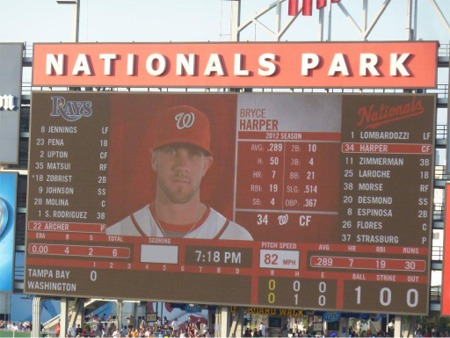 ved
him in favor of Elmer Dessens. Dessens promptly walked Ryan
Zimmerman and gave up a double to Ivan Rodriguez, and got the hook
himself. Manual then brought in Frankie Rodriguez to try to close
the game out. He did close the game out, but not before giving up
RBI singles to Roger Bernadina and Ian Desmond, to add 2 earned runs
to Dessens ledger and ridiculously earn his 19th save,
despite the fact that he came into the game with a 4-run lead and
allowed the 2 base runners he inherited to score. ved
him in favor of Elmer Dessens. Dessens promptly walked Ryan
Zimmerman and gave up a double to Ivan Rodriguez, and got the hook
himself. Manual then brought in Frankie Rodriguez to try to close
the game out. He did close the game out, but not before giving up
RBI singles to Roger Bernadina and Ian Desmond, to add 2 earned runs
to Dessens ledger and ridiculously earn his 19th save,
despite the fact that he came into the game with a 4-run lead and
allowed the 2 base runners he inherited to score.
Although, for some reason I did not
take any in-game photos of the scoreboard in 2010, I did so during a
game in 2012, with rookie phenom Bryce Harper at the plate. I say
this, because I am a fan of their scoreboard. It is similar to the
one at CitiField, where you have both team’s lineups visible at all
times, the linescore, and all the key batter and pitcher stats. The
out of town scoreboard is on the right field wall and has all the
main details of other new stadiums in electronic form. You can
always tell who is pitching, the number of outs, and what bases have
runners on them. This is all fine and good, but I will again say
not quite as good as the ones in Pittsburgh and Philadelphia, which
appear less electronic.
Bottom line – I like this new modern
ballpark. I have had enough of the retro stadiums and think the
Nationals got it right by going modern.
Basic trip facts:
-Stadium - # 40
-Old Stadium Sites visited – None (Total – 39)
-Under construction Stadium Sites visited – None (Total – 3)
-Miles traveled – 9 via Subway (DC Metro) and 4,714 via Air (Totals:
Driving – 19,955, Subway - 110, Amtrak – 460, Air - 26,900, Total –
47,425)
-States, provinces, Districts and/or commonwealths passed through –
Washington, DC (Totals: States – 48, Provinces – 2, Districts – 1,
Commonwealths - 1)
-Seats – Upper Level Behind Home Plate
-Prices: I did not track them
-Credit Card giveaway – None
-First Pitch - 7:05 PM
-Results: Mets 5 – Nationals 3, W – John Niese, L – Luis Atilano, S
– Frankie Rodriguez
-Home team record to date – 28 wins, 22 losses
-Record of “team I was routing for” to date – 21 wins, 29 losses
-Attendance – 24,410
-Lodging – Washington, DC
|